09/06/2023
Exhibit Transports Viewers from Cleveland to Streets, Art Studios of Israel
- Share This Story
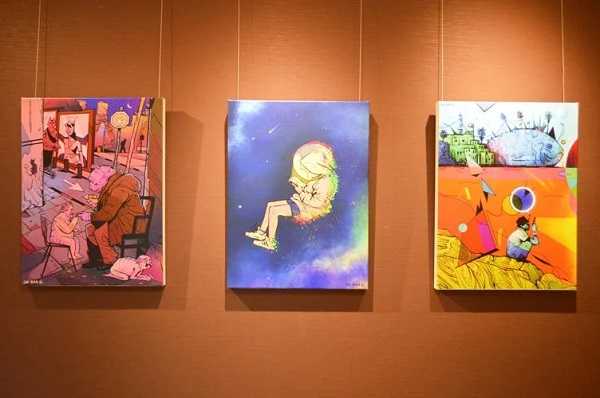
Or Bar-El’s “Street Cat,” “Space Out,” and “Highs and Lows,” all digital prints on canvas. CJN Photo / Courtney Byrnes
COURTNEY BYRNES | CJN
Article reprinted with permission from Cleveland Jewish News
The world is the street artist’s canvas and often unsuspecting passersby are their audience. Many are also studio artists who work in similar styles to their public work and experiment with new media.
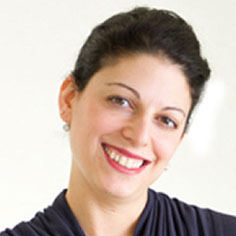
Hurand
Street art is particularly popular in Israel, where graffiti walking tours take tourists and locals to see the different forms of expressions on walls throughout many cities and neighborhoods.
To showcase their work and dig a little deeper into who some of these artists are, “Surface Identities: Studio Works by Israeli Street Artists” is on display through December at the Roe Green Gallery at the Jewish Federation of Cleveland in Beachwood. Sara Hurand serves as the exhibit’s curator.
“I honor the Federation for knowing that street art is worth highlighting as fine art, good art,” Hurand tells Canvas. “If you look at the artists that have been exhibited at the Roe Green Gallery, they are absolutely world class. I give credit to the Federation for acknowledging the work of street artists as world class, and showing it in a comprehensive way.”
Hurand lived in Northeast Ohio from 2001 until 2017, when she moved to Tel Aviv. During her time in Cleveland, she was involved in both the Jewish and art communities, co-founding the Cleveland Jewish Arts & Culture Lab – a Mandel Jewish Community Center program affiliated with the Federation – with Rabbi Zachary Truboff and serving on the Cleveland Israel Arts Connection committee at the Federation since its inception.
Curating her first exhibition for the Roe Green Gallery, she selected 16 Israeli street artists and highlighted 55 of their studio works. As one walks through the exhibit, they get a sense of each artist’s style and maybe even a bit of their story, as the title suggests.
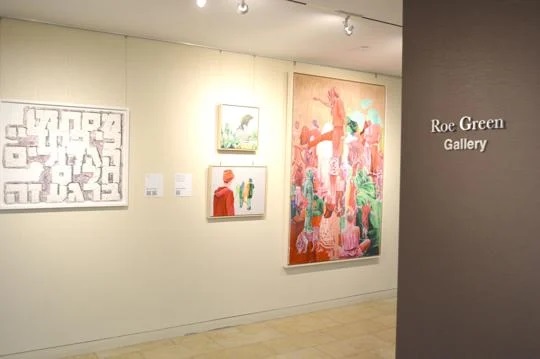
An untitled mixed media piece by Nitzan Mintz, left, next to works by Adi Gershon at the Roe Green Gallery. CJN Photo / Courtney Byrnes
“Surface is implying what you get at first glance, and identity is what you get when you start to look deeper,” Hurand says. “When you encounter street art in real life, you walk by it and might get a clue or tag that gives you an indication of who made it, and maybe not. In this exhibition, we connect the personal stories of the artists with their studio work.”
A UNIQUE CULTURE
Many of the artists featured use alternative names for their public art, common especially among those who got their start when street art was still illegal in some places or seen as societally transgressive, Hurand says.
“The scope, scale and prominence of street art in Israel has been increasing for about 20 years,” she says. “It’s a young, modern society. Many of the artists in this exhibition are part of the originators of the Israeli street art scene, and are now recognized not just in Israel but around the world where they are commissioned to work, sometimes even in cities where their ancestors fled.”
Now, many of them have become famous for their work and utilize social media to interact with their audience. Hurand points to one of the featured artists, Igor Revelis, also known as Klone, who has now begun going by his real name.
The exhibit also highlights artists from many different backgrounds, but have all found themselves on the streets – and in the studios – of Israel. Revelis, Lior Bentov or Pesh Visuals, and Karen Missk or “The MisSk” are three featured artists who were born in Ukraine. Murielle Cohen, also known as Murielle Street Art, was born in Montreal, Canada and immigrated to Israel as a young adult.
“Asking 16 Israelis about their family stories reveals so much about Israel, and these are the artists who dare to ‘shout’ their creative work,” Hurand says. “So, this was at the core, for me, how meaningful curating this exhibition has been. It is fun and complex, just like each of us when we look a little deeper under the surface.”
Debbie Yasinow, director of the Cleveland Israel Arts Connection at the Federation, tells Canvas the exhibit has been in the works for four years, starting before the COVID-19 pandemic.
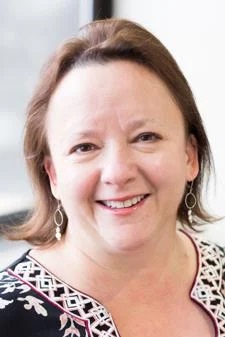
Yasinow
A lot of the works, she points out, were created during the pandemic as everyone was forced inside and they took to their studios more frequently. One exception was Adi Gershon, a studio artist who began pasting her work with colorful decals around the streets of Tel Aviv. One of her featured pieces, “Slightly Transparent,” is a collage of these prints on a wooden board.
“A lot of street artists use the materials they find,” Yasinow says. “It’s plywood, it’s reclaimed. They’re environmental artists, they use recycled materials.”
ARTISTS AND TECHNIQUES
Two other artists featured may be familiar to Clevelanders as Dede Bandaid and Nitzan Mintz’s work was displayed throughout Northeast Ohio last year. Their project, also in collaboration with the Cleveland Israel Arts Connection, was titled “Culture Fix CLE: Healing Our Community Through the Arts” and lined up with the international arts triennial FRONT.
“This (exhibit) is an opportunity to show you how they are artists in the studio, as well as out on the streets,” Yasinow says. “It was something we thought was fun, and it was a great follow up to Dede.”
Other exhibited artists include the art collaborative Broken Fingaz, made up of artists Tant, Deso, Kip and Unga; Brothers of Light; Ben Mashiah, also known as Neo-Apollonia and Noir; Or Bar-El; Noam Dushy, or Swan; Shimon Wanda, or Shimda; Michal Rubin; Guy Bloom, or Dioz; and Itamar Paloge, or Faluja.
The media in the exhibit is eclectic, ranging from digital prints, sculptures, acrylic, watercolor and spray paint on paper, canvas or wood. Giving the free nature of street art as a medium and the various styles and techniques, Yasinow says they had fun displaying the work around the gallery.
“This also posed the entire show some challenges with how do you hang it,” she says. “You don’t want to have everything framed behind glass because that’s not the spirit in which it was created.”
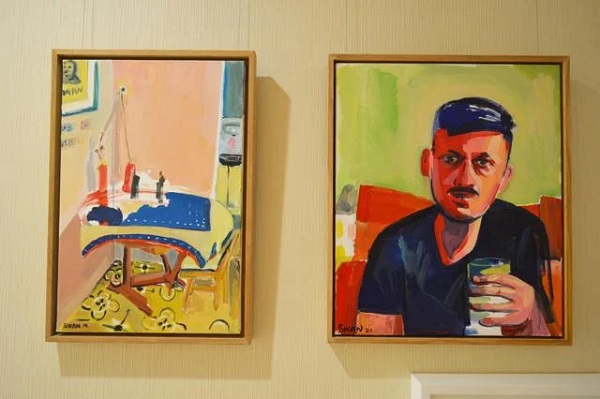
“Room” and “Self Portrait,” both oil on canvas by Swan. CJN Photo / Courtney Byrnes

